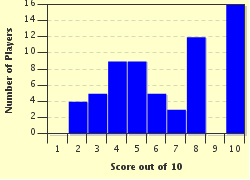Quiz Answer Key and Fun Facts
1. Known for his high-society portraits, this English photographer married a princess.
2. In masterpieces such as "Migrant Mother" and "White Angel Breadline", this photographer captured the poverty and desperation of the Great Depression.
3. Known for his black and white landscapes, this photographer was awarded the Presidential Medal of Freedom for services to conservation.
4. This Hungarian has been called "the greatest combat and adventure photographer of all time" and captured the D-Day landings in 1944.
5. As well as being credited with turning photography into a recognized art form, this American was married to a famous artist.
6. This American was the only Western photographer in Moscow when the Germans invaded the Soviet Union in 1941 and was the first staff photographer for "LIFE" magazine.
7. This high society and royal photographer turned his hand to set and costume design, winning Oscars for his work on "My Fair Lady (1964) and "Gigi" (1958).
8. This Frenchman took photography out of the studio and into the streets and is known as the "father of photojournalism".
9. This Armenian-Canadian photographer is best known for his 1941 photograph of Sir Winston Churchill called "The Roaring Lion".
10. This American photographer was known as the "eye of fashion" and his life was the inspiration for the 1957 film "Funny Face".
Source: Author
KayceeKool
This quiz was reviewed by FunTrivia editor
bloomsby before going online.
Any errors found in FunTrivia content are routinely corrected through our feedback system.

